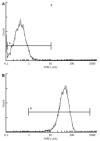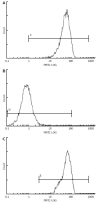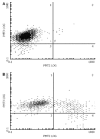Reversal of multi-drug resistance by pSUPER-shRNA-mdr1 in vivo and in vitro
- PMID: 19152447
- PMCID: PMC2653364
- DOI: 10.3748/wjg.15.431
Reversal of multi-drug resistance by pSUPER-shRNA-mdr1 in vivo and in vitro
Abstract
Aim: To explore the possibility of reversing multi-drug resistance (MDR) to HepG2/mdr1 in vitro and in vivo with RNA interference (RNAi).
Methods: HepG2/mdr1 was obtained by cloning the whole gene mdr1 into HepG2 cells. shRNA targeting sequence was designed to be homologous to the P-gp encoding MDR1 mRNA consensus sequence. pSUPER-shRNA/mdr1 was constructed using the enzyme-digested technique. HepG2/mdr1 cells were transfected with vectors of pSUPER-shRNA/mdr1 to measure their efficacy by real-time PCR for mdr1 mRNA, flow cytometry (FCM) for P-gp expression, and Rhodamine efflux, MTT method for HepG2/mdr1 function, respectively. In vivo, mice tumors were treated by injecting pSUPER-shRNA/mdr1 in situ and into intra-abdominal cavity. Tumors were collected to create cell suspension and cryosections after chemotherapy with adriamycin and mytomycin. The cell suspension was incubated in RPMI-1640 supplemented with G418 to screen stable cells for appreciating the reversal of MDR. Cryosections were treated with immunohistochemistry technique to show the effectiveness of transfection and the expression of P-gp.
Results: pSUPER-shRNA/mdr1 was successfully constructed, which was confirmed by sequencing. The MDR phenotype of HepG2/mdr1 was decreased significantly in vitro transfection. HepG2/mdr1 showing its MDR was reversed notably in P-gp expression (11.0% vs 98.2%, P<0.01). Real-time PCR showed that mRNA/mdr1 was lower in test groups than in control groups (18.73+/-1.33 vs 68.03+/-2.21, P<0.001). Compared with HepG2, the sensitivity of HepG2/mdr1 and HepG2/mdr1-dsRNA cells to ADM was decreased by 1.64 times and 15.6 times, respectively. The accumulation of DNR in positive groups was decreased evidently. In vivo, the p-gp expression in positive groups was significantly lower than that in control groups (65.1% vs 94.1%, P<0.05). The tumor suppressing rate in test groups was 57.8%. After chemotherapy, the growth rate in test groups was lower than that in control groups (700.14+/-35.61 vs 1659.70+/-152.54, P<0.05). Similar results were also observed under fluorescence microscope, and confirmed by Image-Pro Plus 4.5 analysis.
Conclusion: pSUPER-shRNA/mdr1 vector system allows simple, stable and durable nonviral knockdown of P-gp by RNAi in malignant cells and animals to restore their sensitivity to adriamycin.
Figures









References
-
- Fire A, Xu S, Montgomery MK, Kostas SA, Driver SE, Mello CC. Potent and specific genetic interference by double-stranded RNA in Caenorhabditis elegans. Nature. 1998;391:806–811. - PubMed
-
- Tuschl T. RNA interference and small interfering RNAs. Chembiochem. 2001;2:239–245. - PubMed
-
- Zamore PD, Tuschl T, Sharp PA, Bartel DP. RNAi: double-stranded RNA directs the ATP-dependent cleavage of mRNA at 21 to 23 nucleotide intervals. Cell. 2000;101:25–33. - PubMed
Publication types
MeSH terms
Substances
LinkOut - more resources
Full Text Sources
Miscellaneous

